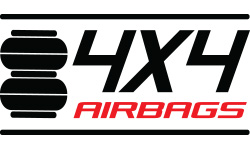Michael Hayes tells you what you need to know about airbag springs for your fourby.
We’ve all heard the rumours and hype surrounding airbag springs used in the back of 4WDs.
There’s no shortage of myths and misinformation flying around. Hands up if you’ve heard these – airbags will change the amount of suspension travel off-road; airbags will often tear under flex; they’ll make the ride hard and bouncy; they’re prone to punctures; vehicles fitted with airbags routinely bend their chassis. Sounding familiar?

Let’s deal with them in order. In most applications, wheel travel is NOT reduced. Well-designed airbags allow for a similar amount of suspension travel regardless of load conditions. In many circumstances due to the lower linear rate of the airbag fitment, it may provide more suspension travel compared to that of fitting traditional heavy-duty load carrying springs.
As for toughness – kits are available to suit lifted vehicles and some are also available with protective abrasion sleeves or covers so that the bags will not get damaged when off-road.
What about the ride? A correctly inflated airbag is only really providing support for the extra loaded mass. For the times when that added load capacity is not required, you simply deflate or reduce the pressure. It is then that an airbag system is superior to having HD springs, which affect the ride in all situations. If you’re noticing bounciness, check your shocks haven’t had it.
Puncture resistance is also good these days. A quality airbag is very durable and resilient (they’ve been used in trucking for years) and will only lose pressure for reasons similar to that of your vehicle’s tyres. So when you check your tyre pressures, check the pressure and condition of the airbags as well.
The bent chassis problem is also vastly overblown. Overloading and / or poorly positioned loads combined with driver error are the common themes here. Always adhere to the vehicle manufacturer’s load and axle ratings, and consult the vehicle manufacturer’s handbook for load positioning and driving recommendations. In some vehicles it is actually far better to spread the load back into the chassis at more points.
With that said, with GU Nissan Patrols and Navaras, running airbags can increase the risk of chassis damage and a suitable brace kit will need to be added before tackling big trips.
But what about off-road performance? In some situations the use of an articulation kit for 4WDs may be required by owners who want increased upward wheel travel and increased droop (downward wheel travel). This is achieved by a top that opens airlines between the two air bellows to allow the passage of air to move from one to the other. This is ideal for rocky 4WD conditions and some outback areas. Air bellows are also great in aiding a loaded 4WD in the bush. When used correctly they can increase both ramp over and departure angles.

Contact Superior Engineering
Phone: (07) 5433 1411499 Uhlmann Road
Burpengary Queensland 4505
Australia
ASK THE EXPERTS: 4X4 Suspension Tech Talk With Superior Engineering
